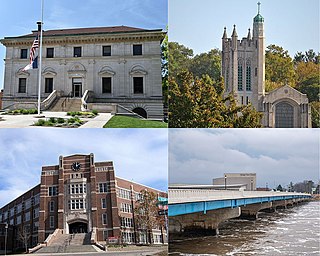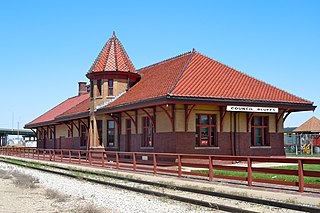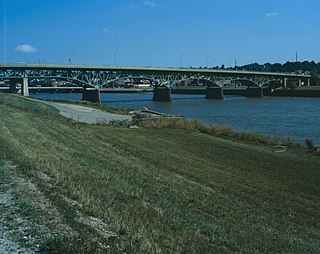
Ottumwa is a city in and the county seat of Wapello County, Iowa, United States. The population was 25,529 at the time of the 2020 U.S. Census. Located in the state's southeastern section, the city is split into northern and southern halves by the Des Moines River.

The Chicago, Burlington and Quincy Railroad was a railroad that operated in the Midwestern United States. Commonly referred to as the Burlington Route, the Burlington, or as the Q, it operated extensive trackage in the states of Colorado, Illinois, Iowa, Missouri, Nebraska, Wisconsin, Wyoming, and also in Texas through subsidiaries Colorado and Southern Railway, Fort Worth and Denver Railway, and Burlington-Rock Island Railroad. Its primary connections included Chicago, Minneapolis–Saint Paul, St. Louis, Kansas City, and Denver. Because of this extensive trackage in the midwest and mountain states, the railroad used the advertising slogans "Everywhere West", "Way of the Zephyrs", and "The Way West".

Saint Paul Union Depot is a historic railroad station and intermodal transit hub in the Lowertown neighborhood of Saint Paul, Minnesota. It serves light rail, intercity rail, intercity bus, and local bus services.

Winona station, formerly known as the Chicago. Milwaukee & St. Paul Railway Station, is a historic train station in Winona, Minnesota, United States. It is served by Amtrak's daily Empire Builder service. It was originally built in 1888 by the Chicago, Milwaukee, St. Paul and Pacific Railroad, known later as the Milwaukee Road. A former Milwaukee Road freight house also exists here.

Plano station, also known as the Chicago, Burlington and Quincy Railroad Depot is an Amtrak intercity train station in Plano, Illinois, United States. The station was added to the U.S. National Register of Historic Places on November 12, 1993.

Princeton station is an Amtrak intercity train station at 107 Bicentennial Drive in Princeton, Illinois. The station was built in 1911 by the Chicago, Burlington and Quincy Railroad and is listed as "Princeton City" on the Amtrak website and the List of Amtrak stations. Amtrak, the Illinois Department of Transportation and the city worked together to renovate the depot in 1998. Over the following six years, a new roof and gutters were installed, brickwork was repaired and the restrooms were upgraded.

Galesburg is an Amtrak intercity train station in Galesburg, Illinois, United States. The station was originally built in 1984, after the razing of the large depot just south of the current site. It is located north of the large BNSF Classification yard. Just south the Illinois Zephyr and Carl Sandburg diverge via the Quincy main line which bypasses the yard on the east side. The California Zephyr and the Southwest Chief continue to the southwest side of Galesburg near Knox College.

Burlington station is an Amtrak train station in Burlington, Iowa, United States. It is served by the California Zephyr, with one daily train in each direction. The station was built by the Chicago, Burlington and Quincy Railroad (CB&Q) in 1944, replacing the previous union station used by the CB&Q and the Chicago, Rock Island and Pacific Railroad. That station burned in January 1943.

Osceola station is an Amtrak intercity train station in Osceola, Iowa, United States served by Amtrak. Osceola is the closest Amtrak station to Des Moines, Iowa's capital and most populous city, which is about 50 miles (80 km) to the north. The station is listed on the National Register of Historic Places as Chicago, Burlington and Quincy Depot.

Holdrege station is an Amtrak intercity train station in Holdrege, Nebraska, served by the California Zephyr. It was originally opened in February 1911 by the Chicago, Burlington and Quincy Railroad as the CB&Q Holdrege Depot, and the depot has been listed on the National Register of Historic Places since February 21, 1997. However, the depot is no longer part of the station facilities.

The Atchison, Topeka and Santa Fe Passenger and Freight Complex is a nationally recognized historic district located in Fort Madison, Iowa, United States. It was listed on the National Register of Historic Places in 1992. At the time of its nomination it contained three resources, all of which are contributing buildings. The buildings were constructed over a 24-year time period, and reflect the styles that were popular when they were built. The facility currently houses a local history museum, and after renovations a portion of it was converted back to a passenger train depot for Amtrak, which opened on December 15, 2021.

RailsWest Railroad Museum is a railroad museum operated by the Historical Society of Pottawattamie County at 16th Avenue and South Main Street and illustrates the history of railroads in Council Bluffs, Iowa.

The Burlington, Cedar Rapids and Northern Railway (BCR&N) was a railroad that operated in the United States from 1876 to 1903. It was formed to take over the operations of the bankrupt Burlington, Cedar Rapids and Minnesota Railway, which was, in turn, the result of merging several predecessor lines, the construction of which began in 1869. The corporate headquarters were in Cedar Rapids, Iowa, and it had operations in Iowa and in Minnesota. It was succeeded by the Chicago, Rock Island and Pacific Railway.

Galesburg Santa Fe Station was a railway station in the west central Illinois town of Galesburg. The station was along the Atchison, Topeka and Santa Fe Railway's main line and served trains such as the Super Chief and El Captain. After Amtrak took over intercity rail in the United States, it was served by trains such as the Lone Star (1971–1979) and the Southwest Chief (1971–1996).

The Jefferson Street Viaduct is a historic structure located in Ottumwa, Iowa, United States. The riveted Warren deck truss bridge was completed in 1936. It was listed on the National Register of Historic Places in 1998 as a part of the Highway Bridges of Iowa MPS.

Centerville station, now known as the Appanoose County Post 526 VFW Hall, is an historic train station located in Centerville, Iowa, United States. The Chicago, Burlington and Quincy Railroad (CB&Q) bought the Keokuk & Western Railroad in 1903. Centerville served as a dividing point on the line and by 1910 the people in the town started to plan for a larger station. Its architect is unknown, but the depot was probably designed by a CB&Q architect using fairly standard plans that were used by the railroad at the time. Construction of the Prairie School style building began in July 1911 and it was completed in February of the following year. Local contractor B.S. Staley built the building. The building was used by the CB&Q until 1982. It was bought by the Appanoose County VFW post for their meeting hall in 1990 and it was listed on the National Register of Historic Places in 2003 as the CB&Q Passenger Depot.

Keokuk Union Depot is a historic train station on the west bank of the Mississippi River near downtown Keokuk, Iowa, United States. It was built from 1890 to 1891, and it was listed on the National Register of Historic Places in 2013.

Creston station is an Amtrak intercity train station in Creston, Iowa. The station is served by the Chicago–San Francisco Bay Area California Zephyr. Constructed by the Chicago, Burlington and Quincy Railroad (CB&Q) and opened in 1899, the station is listed on the National Register of Historic Places as the Chicago, Burlington and Quincy Railroad-Creston Station. Amtrak moved to the historic station in 2019 from a small station immediately to its east that had been used since 1969. Creston station is also used by the city of Creston as a city hall and community center, known as the Creston Municipal Complex.

The Chicago, Milwaukee & St. Paul Depot-Jefferson, also known simply as the Milwaukee Depot is an historic building located in Jefferson, Iowa, United States. The rail line that this station served was built by the Wabash, St. Louis and Pacific Railway in either 1882 or 1883. It was part of the 500 miles (800 km) of track developed by Jay Gould in Iowa. Known as the High Bridge Route because of the height of the bridge over the Des Moines River, it was acquired by the Des Moines, Northern and Western Railroad in 1891. Four years later the Chicago, Milwaukee and St. Paul Railway acquired the line. The Milwaukee Road built this train station from their standard building plan between 1906 and 1909. It is almost identical to the station built in 1906 in Adel, Iowa. This passenger station replaced a combination passenger and freight depot that was moved and used solely as a freight depot. The Milwaukee Road discontinued passenger service in Jefferson in the early 1950s, and the depot continued as a freight office until 1980. The building was listed on the National Register of Historic Places in 1994.

Marion station was a railroad station in Marion, Iowa. It served passenger trains of the Chicago, Milwaukee, St. Paul and Pacific Railroad, commonly known as the Milwaukee Road. After passenger train service was discontinued, elements of the station were moved across the street to City Square Park, where it remains as a pavilion today. The structure is listed as a non-contributing property by the National Register of Historic Places in the Marion Commercial Historic District.
























